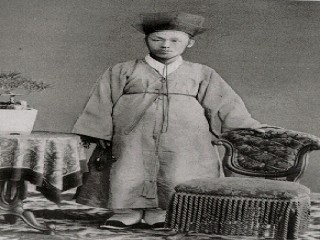
Kim Ok-kyun biography
Date of birth : -
Date of death : -
Birthplace : Korea
Nationality : Korean
Category : Politics
Last modified : 2011-10-11
Credited as : Yi dynasty, Kapsin Ilrok, exile in Japan
Kim Ok-kyun (1851-1894) was a Korean politician in the last decades of the Yi dynasty. He attempted to reform Korean politics and government along the line of the Meiji Japanese development
A son of Kim Byóng-t'e of the city of Kóngju, Kim Okkyun passed with the highest score the state examination of the civil branch in 1872 and served as a middle-ranking government official in various capacities. The Korean government was then dominated by conservative and pro-Chinese officials who habitually followed the leadership of decaying Ch'ing China.
Kim was deeply impressed with the reform and modernization measures of Meiji Japan when he traveled to the neighboring country in 1881. He managed to visit Japan again as an adviser to the Korean envoy Pak Y[?]nghyo, who negotiated a Japanese loan for the Korean government in 1883. Such ties between the Korean and Japanese governments were viewed with unveiled hostility by the pro-Chinese faction of the Korean government. Due to pressures from the conservative faction, Kim was assigned to less and less significant government positions.
Kim allied himself with an increasing number of progressives, who were advocating far-reaching reform and modernization measures. He visited Japan again in 1884 in a vain attempt to negotiate another loan for the purpose of training a modern Korean army. The Chinese-backed faction of the Korean government, led by the Mins, was becoming increasingly anachronistic and oppressive from the standpoint of the progressives.
Kim and other members of the progressive faction (party) decided to eliminate the leaders of the conservative faction, who were to attend the opening of the Bureau of Postal Administration. The plotters were said to have been given a pledge of assistance by the Japanese minister to Korea, Takezoe. At the opening ceremony of the Bureau in
October 1884, the progressives killed Han Kyu-jik and other conservatives and forced the formation of a new Cabinet.
Kim was in charge of financial affairs in the new and short-lived Cabinet that was formed on the day after the "palace coup," but the Cabinet was toppled within 3 days, partly due to "betrayals" by the Japanese minister. Kim was driven to exile in Japan, where he hid himself for 10 years from the reaches of assassins sent by the Korean government, which regarded him as a traitor. In 1894 he moved to Shanghai, where he was killed by Hong Chong-u, an assassin dispatched by the faction in Korea, some of whose members had been liquidated in the coup. Kim's body was returned to Korea to be dismembered as a warning to "traitors."
The Kapo Reforms of 1894, touched off largely by the Japanese troops who entered Korea as an aftermath of the Tonghak (Eastern Learning) rebellions, drove the pro-Chinese group out of power, and Kim's name as a traitor was posthumously cleared. Kim was the author of the Kapsin Ilrok (Diary of the Year Kapsin) and Ch'ido yaknon (Treatises on Governing), among other works.
There is no detailed information on Kim available in English works. His life and political activities are discussed in Clarence Norwood Weems's edition of Homer B. Hulbert, History of Korea (1962). Brief mentions of his career as a leader of the Korean Progressives of his time are in Fred Harvey Harrington, God, Mammon, and the Japanese (1944). □
















